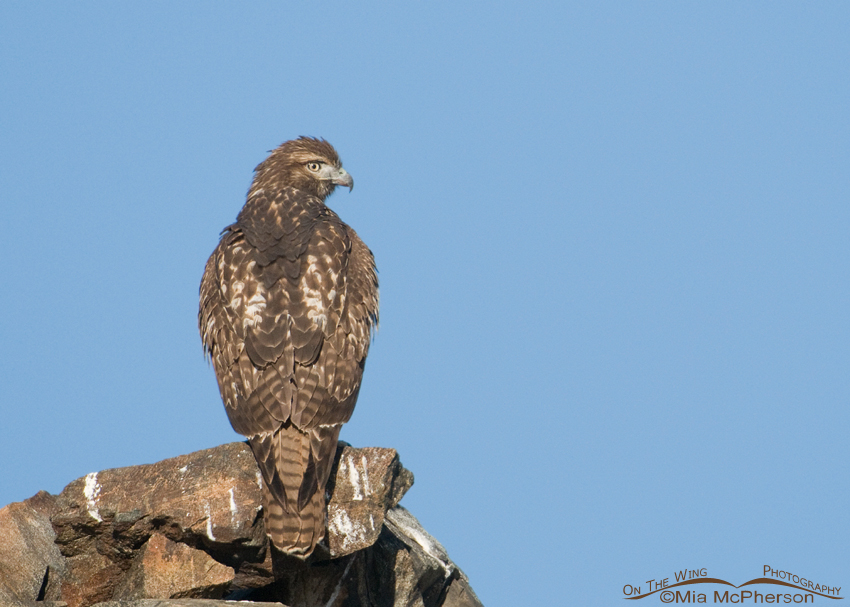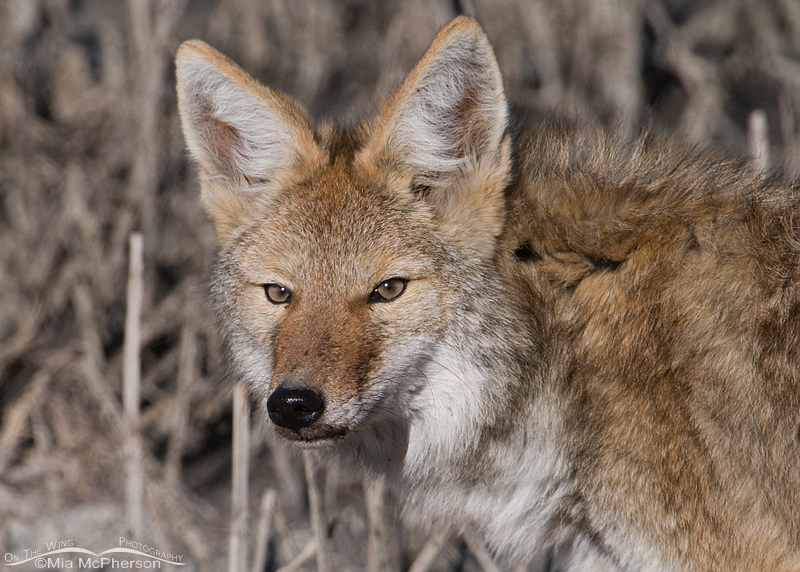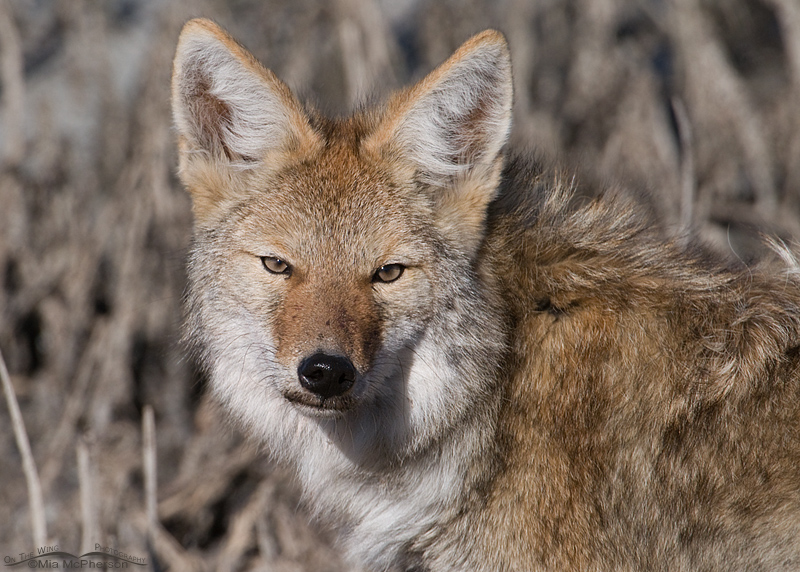 Adult Prairie Falcon on shoreline rocks – Nikon D300, f6.3, 1/200, ISO 1000, +0.3 EV, Nikkor 200-400mm VR with 1.4x TC at 400mm, natural light, not baited
Adult Prairie Falcon on shoreline rocks – Nikon D300, f6.3, 1/200, ISO 1000, +0.3 EV, Nikkor 200-400mm VR with 1.4x TC at 400mm, natural light, not baited
Kind a of a crazy title but it is a mantra that I live by when it comes to my bird and nature photography. It simply means that unless I go out shooting I won’t know what I am missing.
Yesterday morning started off in an exciting way when I spotted a California Gull chasing a bird over the Great Salt Lake, the bird that was being chased moved fast. Really fast.
I noticed the shape then the color and realized it was a falcon but I wasn’t sure which one, a Prairie or a Peregrine. Then the falcon broke away from the gull, headed towards the shore and perched on a boulder. By then I knew it was a Prairie Falcon.
The sun had risen and there was gorgeous golden light on the falcon when it was flying around with the gull but the boulder where it landed was still in the shadows and I didn’t have that great, warm light.
I had to raise my ISO to 1000 to just get 1/200 for my shutter speed and I increased my exposure compensation to +0.3 to expose the bird well in the light I had. Because I didn’t have to lighten the bird or anything else in the frame I avoided unwanted noise.
Noise happens when an image isn’t properly exposed in the camera and post processing can make it much more noticeable when the exposure is raised then.
Color noise is even worse, for instance after raising the exposure in post processing specks of odd colors like green, yellow and red can show up in feathers that are supposed to be black, dark brown or even light colors. If my images show even the slightest bit of color noise… they go into my delete bin.
Exposing correctly in the camera produces a much better image and one that will require less time and work in post processing.
That said; this image was slightly flat right out of the camera so I selected a warmer white balance in Adobe Camera Raw (ACR) when working with the raw file, I saw that I needed a bit more black and increased that then bumped up the contrast slightly by using a curves layer.
I finished up by masking the bird and the boulder it is perched on and applied some smart sharpening.
You can still tell this image was taken in low light and that the post processing looks very natural not artificial or over processed.
It felt great to have a Prairie Falcon be the first bird I photographed.
After publishing edit: I should mention that the gull that had been chasing the falcon landed on the water underneath of where I first saw the birds, there were a couple other gulls already on the water.
I noticed something moving between two of the gulls and scoped it with my lens. I could see an Eared Grebe in distress, listing on its side with its legs out of the water and fluttering.
I can’t be certain but it is possible that the Falcon had struck the grebe though I am not sure why the gulls were staying close to it. When the falcon left it did not fly to the grebe but flew west away from it.
 Red-tailed Hawk juvenile high up on the rocks – Nikon D300, f6.3, 1/1600, ISO 640, +0.3 EV, Nikkor 200-400mm VR with 1.4x TC at 400mm, natural light, not baited
Red-tailed Hawk juvenile high up on the rocks – Nikon D300, f6.3, 1/1600, ISO 640, +0.3 EV, Nikkor 200-400mm VR with 1.4x TC at 400mm, natural light, not baited
Later on in the morning I spotted one of the juvenile Red-tailed Hawks (Buteo jamaicensis) I’ve been photographing for over two months now. The immature Red-tailed was perched on some rocks above the road with its back towards me and it pretty much stayed in that position until it lifted off from the outcropping. Of course it lifted off facing away from me. I have taken tons of those butt shots during my time photographing birds and they were deleted right away. This juvenile didn’t cooperate much yesterday but that is okay, I’ll likely have more opportunities with this bird and its siblings again.
It wasn’t particularly “birdy” on the island but the sky was blue, the light was wonderful, the scenery spectacular and any day spent in the field is a true pleasure for me.
 Western meadowlark on a salt-encrusted boulder – Nikon D300, f6.3, 1/3200, ISO 640, Nikkor 200-400mm VR with 1.4x TC at 400mm, natural light
Western meadowlark on a salt-encrusted boulder – Nikon D300, f6.3, 1/3200, ISO 640, Nikkor 200-400mm VR with 1.4x TC at 400mm, natural light
At the area near the marina and saw this Western Meadowlark perched on a boulder near the water line, just a few weeks ago these boulders looked black with thousands & thousands of Brine Flies covering them but yesterday the true colors of the boulders were apparent as was the salt that has become encrusted on them from being so close to the hyper saline Great Salt Lake.
There are very few Brine Flies now because of the much cooler temperatures.
While I was photographing this bird some movement to my right caught my attention.
 Coyote Portrait I – Nikon D300, f9, 1/1250, ISO 640, Nikkor 200-400mm VR with 1.4x TC at 400mm, natural light, not baited or called in
Coyote Portrait I – Nikon D300, f9, 1/1250, ISO 640, Nikkor 200-400mm VR with 1.4x TC at 400mm, natural light, not baited or called in
It was a Coyote moving along the shoreline almost parallel to the truck and water. My problem was that even when I backed my zoom to 200mm the coyote was too large in the frame so I zoomed back out to 400mm and took portrait images of it.
 Coyote Portrait II – Nikon D300, f9, 1/1250, ISO 640, Nikkor 200-400mm VR with 1.4x TC at 400mm, natural light, not baited or called in
Coyote Portrait II – Nikon D300, f9, 1/1250, ISO 640, Nikkor 200-400mm VR with 1.4x TC at 400mm, natural light, not baited or called in
It isn’t everyday that I am so close to a Coyote that I can get portrait images like these so I was very happy that I listened to the words “You’ll never know unless you go” that I hear in my head most mornings before going out into the field.
Mia


A truly awesome day in the field Mia! To begin the day with a Prairie Falcon is such a positive omen. Thank you for the great information on your camera settings. I definitely need to take a class on my Nikon to learn how to take better images without having to post process. What a joy that must be! From the looks of that rock outcropping it looks like a favorite of the Red-tailed Hawk. My favorite images have to be the Coyote portraits. I have never been that close to a Coyote. The second shot is such a wonderful pose, I find it difficult to understand how people have been killing them for hundreds of years. A beautiful animal indeed!
Thank you Larry, it was an awesome day in the field and I always LOVE when my day starts with a falcon (or two). Yes, there is a lot of white wash on the rocks the Red-tailed Hawks like to perch on. Like you I have a very difficult time understanding how (and why) people have been killing Coyotes for so long. They are important to a healthy and balanced environment. Maybe one day the people in office who make the decisions to kill themn will see that. I hope.
Wow! Gotta go! Great photos!
Dawn, thanks for commenting, hope you are on the go
It looks like you had a productive outing, here. I have never seen a prairie falcon before. What a handsome bird.
I agree Julie, Prairie Falcons are handsome birds! Thanks for commenting.
That first image is so very perfect in every respect but the beauty of the falcon’s feathers is the best part. So beautiful. Love the meadowlark. The coyote looks very intent in his search. Carol
Thank you Carol. I love the feathers on the falcon too.
Most excellent!! I seen the falcon on my way out but it was way to dark. Thanks for shareing.
Thanks Earl, I saw the falcon again the other day but it stayed too far away fro good images of it but I did see it attack a Northern Shoveler on the south side of the causeway near the marina. Wow, that was some great action.
P.S., on your title “you never know”, co-incidentally my post tomorrow will be similar. Ann and I had such an experience this morning.
Bob, I loved your post that matched my “You’ll never know”!
Wonderful shots, Mia. I love the way you describe your processing. However, much of it (curves, etc.) is over my head, and I just have to ‘tinker’ around. (see my post yesterday). I wish I had a companion locally that was an expert on processing, and I could sit down next to him, or her, and learn all these methods. But I love your images.
Thanks Bob. Post processing skills do take time to develop, ask Ron!
enjoyed your info..and the photos are fabulous..love the coyote..the eyes make you wonder what he is thinking..love your slogan..it is so true for all of life..take care and have Marvelous Monday!!
Thank you Syl, I appreciate your thoughs and comments on this post.
Great shots Mia, as always. It was very interesting and informative to read about your processing methods too–an aspect of photography about which I’ve stayed very in-the-dark and removed, but must probably tackle some day if I’m going to improve.
Laurence, I do hope my processing tips are informative, thanks for saying that they are and commenting on the images.
Awesome catches, Mia. Especially love the coyote portraits!
Thanks Jim!
What a wonderful post! I love the title (which is so true), as well as the portraits of the Coyote:)
Thanks Susan, I’m quite fond of my mantra and of these Coyote portraits!
Brilliant post, my favourite is the Coyote, he looks so serene. Superb photos.
Thank you Bob, I love Coyotes and was very pleased to get these portraits of it.
Wonderful post! I enjoyed reading the whole thing but especially your workflow, settings, etc. Great shots of the coyote! The eyes have it!!!
Thanks much Beverly, the amber eyes of Coyotes mesmerize me.
The portraits of the coyote are priceless, especially #1. I love filling the whole frame with the subject, which is of course much harder to do because you need to either get closer or rely on the lens and/or cropping. I love this coyote portrait. And the title of your post is so try. “You never know unless you go” is so true.
Maria, this coyote was so close that I would have been either clipping body parts or there wouldn’t have been enough space around the coyote for a pleasing composition. It isn’t often that happens with a Coyote. I’m glad you enjoyed the portraits, thanks for commenting.